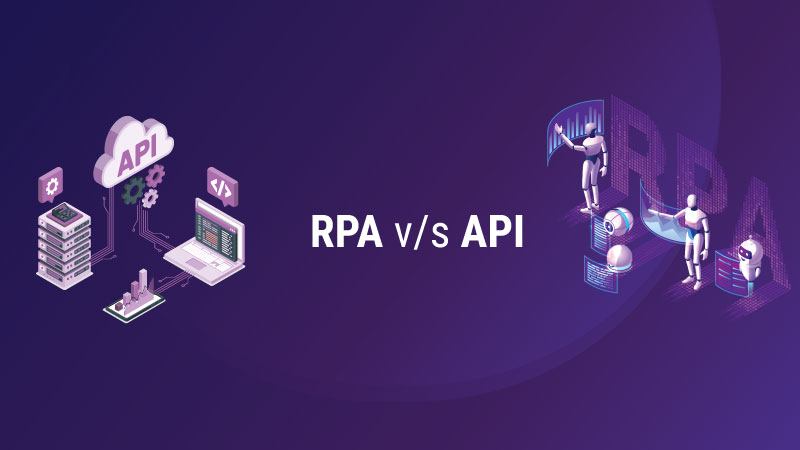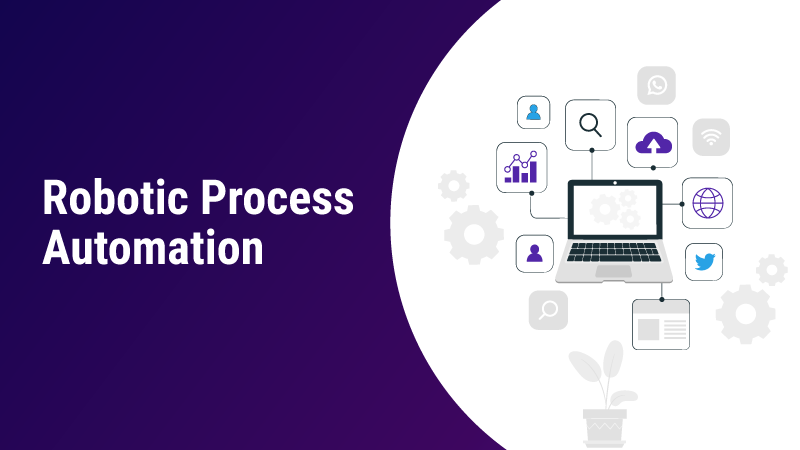Robotic Process Automation Vs. API

The process of automation has reached the point where it has achieved its own recognition and status as a result of various technologies involved in it. Robotic Process Automation (RPA) is one such advanced technology. It is the type of automation that emulates human-like features and functions way better than humans. Another one is the Application Programming Interface (API). It facilitates interaction between applications. When it comes to selecting one of them, businesses mostly get confused. In most situations, a hybrid strategy is the best choice, in which API integrations are used for certain operations and RPA for the larger framework. Let us have a discussion on these technologies and what they can offer you.
What is RPA?
RPA stands for Robotic Process Automation, a technology in which an automation software bot is used to interact with applications in the same way that a human worker would do. To be precise, RPA bots emulate human actions and performances to finish a task through a series of steps, in an ‘automated manner’. The term ‘automated manner’ indicates that the task is operated entirely by the device itself without any human intervention. Moreover, RPA technology aims to reduce the time and cost spent on manual tasks performed by human laborers as it automates the entire process. Some of the areas where RPA is deployed include:
- Accounts payable
- Human Resources
- Customer relations
- Invoice processing
- Credit card applications
What is API?
An application programming interface (API) is a set of established protocols, codes, and definitions that describe how computers or applications interact with each other. APIs serve as a mediator that occupies between an application and a web server, thereby processing the transfer of data between systems. API also allows a product or service to interact with others without having to learn how they apply to other products and services. As you design or manage new tools and products, the API provides you with enough flexibility, simplified innovation, and room for creativity. With API integration of different applications, the data flow and availability will become more efficient and the time to perform various tasks will be reduced. Some of the areas where API integration is used include:
- Universal logins
- Text messages
- Network Integration
- Google map services
- Travel bookings
RPA vs API
RPA and API, two are similar and can be used to automate tasks. But when it comes to the business world, both have different purposes. For instance, RPA can automate a single application or a group of applications. It is built to perform a specific business process or on a common platform. Meanwhile, API acts as a doorway between systems and services. It enables you to integrate various applications and services together.
RPA communicates with the target applications through the front end. Software bots perform actions much similar to human employees with more speed and accuracy. API uses a different method and it communicates with the target applications via the back end.
Though building an RPA tool takes less time and money when compared to API, the maintenance cost of RPA is higher than API.
Both RPA and API are designed to eliminate human intervention in business processes, but the approaches used by both are totally different. RPA helps in automating business processes by emulating human actions whereas API is used to connect software systems in order to facilitate direct interaction.
RPA vs API: Pros and Cons
Integration of applications using RPA platforms and APIs is a part of digital conversion initiatives. Both approaches have their own advantages and disadvantages when we look into their general definition and performance.
Pros of using RPA
Robotic Process Automation has revolutionized the automation process, which has brought many benefits in different fields. Here are the different benefits of Robotic Process Automation.
Supports legacy systems
Most legacy systems do not disclose their APIs even if it is commercial software or an in-house application. RPA support legacy system and it is capable of emulating human interactions with old systems which enables them to be a part of the automation and modernization efforts. Thereby successfully incorporating legacy systems rather than replacing them.
Well defined projects
Fixing the requirements right is one of the most challenging features of IT projects. Since RPA has a high success rate, it can be used in processes that are already well-established and synchronized with well-understood applications. As API projects include new applications and processes, it may take many turns to attain the desired result.
Modeling business processes
RPA can quickly and easily model a business process by mimicking and recording the performance of a human employee against a UI. Modeling a business process and developing a service using APIs can be very costly. Meanwhile, the RPA can succeed from the overall perspective of the total cost of ownership.
Packaging business process
RPA offers a packaged solution to any specific business problem you aim to address. It does not give you a chance to worry about the inner working because RPA platforms will cover A to Z things in a single stretch. However, they do not promise the flexibility that an API can offer you.
Cons of RPA
- The scalability of RPA is less when it comes to high-speed workflow transactions.
- RPAs require high maintenance as software requirements keep varying according to business needs.
- RPA can make existing processes efficient, but it may not be able to improve them.
Pros of using API
Here are the different benefits of the Application Programming Interface.
Reuse
APIs are an integrated collection of methods that perform a single function, which can be the basis of an application or service or an RPA. Businesses can greatly benefit from portability as they can use them again for various purposes, unlike RPA which serves a single purpose.
Fast and efficient
APIs can be commended for their live connectivity benefits because of their ability to connect rapidly and efficiently with their partner and SaaS applications.
APIs are everywhere
APIs are universal in business. With the beginning of modern software applications publishing their APIs, it has become easier to develop connectors that sync those applications.
Good for nuanced problems
The benefits of RPA are sometimes limited to minor business processes such as data entry or simple end-to-end setup. Many business processes are much more subtle than this and based on scenarios that include complex integration of data or applications to function as needed. The issue becomes more complex in the reality that IT landscapes depend more on cloud applications. This increases the need for better data management and administration in API tools.
Cons of API
- APIs are rather expensive and require a lot of time to develop, than RPA.
- Changes to the API need to be linked to a formal IT change process.
- API has no universally accepted standard format.
Wrap up
Robotic process automation (RPA) and application programming interface (API) have their own benefits depending on the requirements and necessities of the company or business. Mostly it depends on two factors – the business needs and the budget limitations. APIs are an excellent tool for high-capacity transactions, but an API integration is practical only if it is already available, and the specific problem should be defined. Robotic Process Automation is comparatively inexpensive and fast to implement but needs continuous and thorough support to ensure success. The pros and cons of both are discussed here in this article and the use of both technologies together would be a better option for your business in all aspects.
Get Started with our RPA Services0 thoughts on “Robotic Process Automation Vs. API ”
Leave a Reply
Blogs by Category
AppForms Artificial Intelligence Blockchain Call Centers Chatbots Cloud Computing Data Management Design Digital Marketing Digital Transformation Enterprise Applications FinTech Insights LowCode Development Microsoft Mobile Apps News Office 365 Robotic Process Automation Security SharePoint Software Development Web ApplicationWhat is Robotic Process Automation? RPA Explained

2024-05-23 16:56:57
This answers most of the questions I had regarding integration of RPA and API. Thank you!